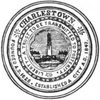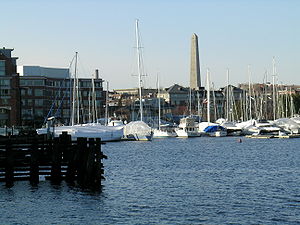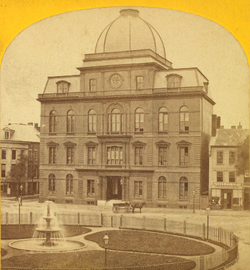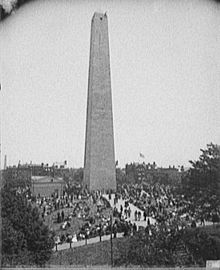- Charlestown, Boston
-
Coordinates: 42°22′31″N 71°03′52″W / 42.37528°N 71.06444°W
Charlestown — Neighborhood of Boston — Charlestown's former City Hall 
SealMotto: Liberty A Trust To Be Transmitted To Posterity Settled 1628 Incorporated 1847 Annexed by Boston 1874 Time zone Eastern (UTC-5) - Summer (DST) Eastern (UTC-4) Area code(s) 617/857 Charlestown is a neighborhood of Boston, Massachusetts, United States,[1] and is located on a peninsula north of downtown Boston. Charlestown was originally a separate town and the first capital of the Massachusetts Bay Colony; it became a city in 1847 and was annexed by Boston on January 5, 1874. While it has had a substantial Irish American population since the migration of Irish people during the Great Irish Famine of the 1840s, since the late 1980s the neighborhood has changed dramatically because of its proximity to downtown and its colonial architecture. However, it still maintains a strong Irish American population and identity.
Contents
History
Thomas and Jane Walford[2] were the original English settlers of Mishawaum (later Charlestown); they settled there in 1624. They were given a grant by Sir Robert Gorges, with whom they had settled at Wessagusset (Weymouth) in September 1623. John Endicott, first governor of Massachusetts Bay Colony, had sent William, Richard and Ralph Sprague to Mishawaum to lay out a settlement. Thomas Walford, acting as an interpreter with the Massachusetts Indians, negotiated with the local sachem Wonohaquaham for Endicott and his people to settle there. Although Walford had a virtual monopoly on the region's available furs, he welcomed the newcomers and helped them in any way he could, unaware that his Episcopalian religious beliefs would cause him to be banished from Massachusetts to Portsmouth, New Hampshire within three years.
Originally a Puritan English city during the Colonial era (a time to which many of the neighborhood's structures date), Charlestown was founded in 1628, and settled July 4, 1629, by Thomas Graves, Increase Nowell, Simon Hoyt, Rev. Francis Bright, Ralph, Richard and William Sprague and about 100 others who preceded the Great Migration. John Winthrop's company stopped here for some time in 1630, before deciding to settle across the Charles River at Boston.
 1629 site of Puritan leader John Winthrop's "Great House" in City Square, uncovered during the Big Dig
1629 site of Puritan leader John Winthrop's "Great House" in City Square, uncovered during the Big Dig
 Birdseye view of Boston, Charlestown, and Bunker Hill, between 1890 and 1910
Birdseye view of Boston, Charlestown, and Bunker Hill, between 1890 and 1910
The territory of Charlestown originally included what is now Melrose and Malden (both until 1649),[3] Stoneham (until 1725),[4] Somerville (until 1842), Medford, Everett, Woburn, Burlington, and parts of Arlington and Cambridge.[5] On June 17, 1775 the Charlestown Peninsula was the site of the Battle of Bunker Hill. Much of the battle took place on Breed's Hill, which overlooked the harbor and the town and was only about 400 yards from the southern end of the peninsula; Bunker Hill is near the northwest end of the peninsula, close to Charlestown Neck and about a mile from the Charles River. The town, including its wharves and dockyards, was destroyed by fire during the battle.
Around the 1860s an influx of Irish immigrants arrived in Charlestown. The neighborhood remained an Irish stronghold in the cultural, economic, and Catholic traditions of neighborhoods like South Boston, Somerville, and Dorchester. The city developed a water supply from the Mystic Lakes.[6] On October 7, 1873, a vote was held to determine whether Charlestown should leave Middlesex County and join Boston as part of Suffolk County; Boston residents approved the question, 1860–1868, and Charlestown residents also approved, 1940-1947.[7]
During the early 1960s, the Boston Redevelopment Authority (BRA) initiated plans to demolish and redevelop sixty percent of the housing in Charlestown.[8] In 1963, the BRA held a town meeting to discuss their plans with the community. The BRA's dealings with Boston's West End had created an atmosphere of distrust towards urban renewal in Boston, and Charlestown residents opposed the plan by an overwhelming majority. By 1965, the plan had been reduced to tearing down only eleven percent of the neighborhood, including the removal of the elevated rail tracks.[citation needed]
Throughout the 1960s until the middle 1990s, Charlestown was infamous for its Irish Mob presence. Charlestown's McLaughlin Brothers were involved in a gang war with neighboring Somerville's Winter Hill Gang, during the Irish Mob Wars of the 1960s. In the late 1980s, however, Charlestown underwent a massive gentrification process similar to that of the South End. Drawn to its proximity to downtown and its colonial, red-brick, row-house housing stock, similar to that of Beacon Hill, many upper-middle class professionals moved to the neighborhood. In the late 1990s, additional gentrification took place, similar to that in neighboring Somerville.[citation needed] Today the neighborhood is a mix of upper-middle and middle-class residences, housing projects, and a large working class Irish-American demographic and culture that is still predominant.[citation needed].
Charlestown was the setting for the 2010 action thriller The Town, directed by and starring Ben Affleck, which follows the lives of a group of Boston bank robbers and the law enforcement personnel attempting to stop them.
Geography
 Sailboats moored on the Charlestown side of the Charles River with Bunker Hill Monument in the distance
Sailboats moored on the Charlestown side of the Charles River with Bunker Hill Monument in the distance
Charlestown is located north of downtown Boston on a peninsula extending southeastward between the Charles River and the Mystic River. The geographic extent of the neighborhood has changed dramatically from its colonial ancestor. Landfill operations have expanded much of Boston, lowering hills, and have expanded Charlestown, eliminating the narrow Charlestown Neck that connected the northwest end of the Charlestown Peninsula to the mainland. The original territory also included present-day Somerville, which was incorporated as a separate town in 1842, and the northern part of Arlington. At the time, the Charlestown Peninsula was urbanizing, while Somerville was still largely rural.
City Square in the southern part of Charlestown is the location of the historic city hall. It is also the terminus of the Charlestown Bridge and the former Warren Bridge, and was formerly a stop on the Charlestown Elevated. The Central Artery was built between 1951 and 1954, routing elevated ramps through City Square. The Central Artery North Area (CANA) project moved these underground, into the City Square Tunnel, making way for a revitalized surface park.
Thompson Square is located at the confluence of Main Street, Dexter Row, Green Street, and Austin Street. It was also formerly a stop on the Charlestown Elevated.
Government and infrastructure
The Massachusetts Department of Correction operated the Charlestown State Prison until its closure in 1955. The former prison site is occupied by Bunker Hill Community College.[9]
The United States Postal Service operates the Charlestown Post Office.[10]
Places of interest
Charlestown contains several places of historical interest, many of which are marked by the northern end of Boston's Freedom Trail. The Freedom Trail ends at the Bunker Hill Monument commemorating the famous Battle of Bunker Hill. The USS Constitution, the oldest commissioned vessel in the US Navy, is docked in the Charlestown Navy Yard. Charlestown was also the location from which Paul Revere began his famous "midnight ride" before the Battles of Lexington and Concord. A restaurant opened in 1780 and still in operation, Warren Tavern, claims to have been one of Revere's favorite taverns. Of Charlestown's churches, St. Mary's (1887–1893) is considered one of the masterpieces of Patrick Keely.
Education
Primary and secondary schools
Boston Public Schools operates public schools. Harvard/Kent Elementary School,[11] Clarence R. Edwards Middle School,[12] Warren/Prescott K-8 School,[13] and Charlestown High School are located in Charlestown.[14]
The Holden School, a private school, was formerly located in Charlestown. COMPASS, Inc. and the Holden School merged on July 1, 2007, and the combined system operated at two sites, including the Charlestown site, beginning in September 2007. The COMPASS board of directors decided to close the Charlestown site, beginning on June 26, 2009.[15]
Colleges and universities
Bunker Hill Community College's main campus is located in Charlestown.[9]
Public libraries
Boston Public Library operates the Charlestown Branch. The library first opened in the Warren Institution for Savings building on January 7, 1862. The library moved to a larger space in the new Charlestown City Hall in 1869. In 1913 the branch moved to the intersection of Monument Avenue and Monument Square, in proximity to the Bunker Hill Monument. The branch moved to its current location in 1970.[16]
Notable residents
Charlestown was the burying place of John Harvard, namesake of Harvard University.
- Charles R. Adams, (1834–1900), Charlestown native, opera singer[17]
- Charles B. Atwood, (1849–1895), born in Charlestown, architect who designed the Reliance Building, among others[17]
- William Austin, (1778–1841), born in Charlestown, state legislator and author[17]
- Albert Gallatin Blanchard, (1810–1891), born in Charlestown, Confederate general in the American Civil War
- James Frothingham, (1786–1864), portrait artist
- Robert Haswell, (1768-c1801), maritime trader and officer in the United States Navy during the Quasi-War with France
- Howie Long, NFL-decorated Hall of Fame lineman for the Oakland Raiders
- Samuel F. B. Morse, (1791–1872), artist and inventor
- Woolson Morse, (1858–1897) relative of Samuel F. B. Morse, born in Charlestown and became a noted Broadway composer in the 1890s
- Jack O'Callahan, member of 1980 "Miracle on Ice" hockey team that upset the Soviet Union at Lake Placid, and beat Finland for the gold
- Robert Sedgwick, (c.1611–1656), merchant, first major general of the Massachusetts Bay Colony and first governor General of Jamaica[18]
- Daniel C. Stillson [1], (1830–1899), inventor of the Stillson pipe wrench
- Jim Vesey, (b. 1965) in Charlestown, retired ice hockey player
See also
- Charlestown Navy Yard
- Mayors of Charlestown
- The Town
References
- ^ "Boston's Neighborhoods: Charlestown". Boston Redevelopment Authority (BRA). 2010. http://www.bostonredevelopmentauthority.org/neighborhoods/Neighborhoods.asp?action=ViewHood&HoodID=4. Retrieved August 17, 2010.
- ^ "Walford Family Line". http://kristinhall.org/fambly/Walford/WalfordName.html. Retrieved 2009-05-04.
- ^ "A Condensed History of Melrose". http://www.cityofmelrose.org/Interns%2007/a_condensed_history_of.htm. City of Melrose. Retrieved 2010-07-15
- ^ R. H. Howard and Henry E. Crocker, ed (1880). A History of New England. Volume 1. Boston: Crocker & Co.. p. 202. http://babel.hathitrust.org/cgi/m/mdp/pt?seq=228&view=image&size=100&id=mdp.39015014744588&u=1&num=202.
- ^ History of the Town of Medford, p. 2
- ^ http://www.mwra.state.ma.us/04water/html/hist1.htm
- ^ "The Result in Figures", The Boston Globe, p. 5, October 8, 1873.
- ^ Jones, Michael, The Slaughter of Cities: Urban Renewal and Ethnic Cleansing p529, St. Augustine's Press, South end Indiana, 2004. ISBN 1587317753
- ^ a b Barbo, Theresa Mitchell. The Cape Cod Murder of 1899: Edwin Ray Snow's Punishment and Redemption. The History Press, 2007. 29. Retrieved from Google Books on May 23, 2010. ISBN 159629227X, 9781596292277.
- ^ "Post Office Location - CHARLESTOWN." United States Postal Service. Retrieved on May 23, 2010.
- ^ "Harvard/Kent Elementary School." Boston Public Schools. Retrieved on May 23, 2010.
- ^ "Clarence R. Edwards Middle School." Boston Public Schools. Retrieved on May 23, 2010.
- ^ "Warren/Prescott K-8 School." Boston Public Schools. Retrieved on May 23, 2010.
- ^ "Charlestown High School." Boston Public Schools. Retrieved on May 23, 2010.
- ^ "Holden School." COMPASS. Retrieved on May 23, 2010.
- ^ "Charlestown Branch Library." Boston Public Library. Retrieved on May 23, 2010.
- ^ a b c Who Was Who in America, Historical Volume, 1607–1896. Chicago: Marquis Who's Who. 1963.
- ^ A Sedgwick Genealogy, Descendants of Deacon Benjamin Sedgwick. New Haven: New Haven Colony Historical Society. 1961.
Further reading
- Sammarco, Anthony Mitchell, Charlestown, Arcadia Publishing, Images of America series, 2004
External links
- Boston Public Library on Flickr. Photos of Charlestown
- The Charlestown Neighborhood Council - the elected representative group for the community
- One of the community's web sites
- History in pictures and maps
Neighborhoods in Boston Allston/Brighton · Back Bay · Bay Village · Beacon Hill · Charlestown · Chestnut Hill · Chinatown · Columbia Point · Dorchester · Downtown Crossing · East Boston · Fenway–Kenmore · Financial District · Forest Hills · Fort Point · Government Center · Hyde Park · Jamaica Plain · Leather District · Longwood · Mattapan · Mission Hill · North End · Readville · Roslindale · Roxbury · South Bay · South Boston · South End · West End · West Roxbury
 Categories:
Categories:- Neighborhoods in Boston, Massachusetts
- Former cities in Massachusetts
- Irish-American neighborhoods
- Populated places established in 1628
- Charlestown, Boston
- Former municipalities in Boston, Massachusetts
Wikimedia Foundation. 2010.



